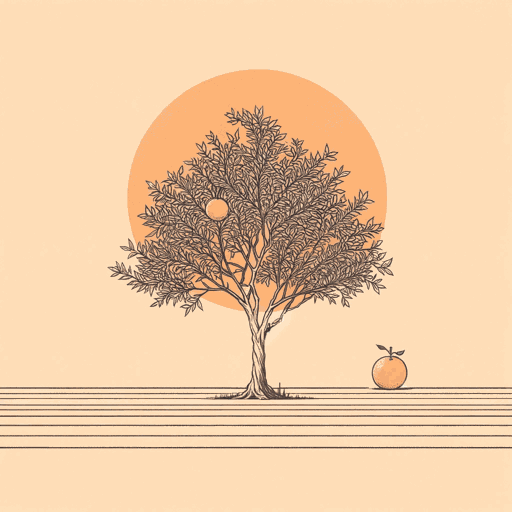68 pages • 2 hours read
Karen Tei YamashitaTropic of Orange
Fiction | Novel | Adult | Published in 1997A modern alternative to SparkNotes and CliffsNotes, SuperSummary offers high-quality Study Guides with detailed chapter summaries and analysis of major themes, characters, and more.
Summary and Study Guide
Overview
Tropic of Orange is a 1997 magical realism novel by Japanese American writer Karen Tei Yamashita. Taking place primarily in Los Angeles, the novel begins on the longest day of the year and spans the course of a week; it covers a magical event that begins in Mexico on the Tropic of Cancer and spreads north to Los Angeles. The story is told from the perspective of seven diverse principal characters; each character gets a chapter devoted to their events on each specific day, with many of the characters not meeting until the final act, if ever. The novel explores the major themes of native resistance to colonialism, and the diverse cultures that coexist in major cities. It also looks at the interconnectedness of people in a large urban environment and explores elements of diaspora and immigrant culture, and how that informs the characters’ decisions.
Plot Summary
Tropic of Orange begins in Mazatlán, Mexico on the longest day of the year. Rafaela Cortes is a worker at the house of journalist Gabriel Balboa. Gabriel is a reporter for a major Los Angeles newspaper, and his success has allowed him to purchase a property on the Tropic of Cancer. He has built a house there, but it seems perpetually unfinished. Rafaela, whose own marriage is troubled, has taken a job supervising construction on the property and reporting to Gabriel. Gabriel has planted many trees on his property, and one of them is an orange tree planted directly on the Tropic of Cancer. This tree is believed to be a descendant of the first orange trees brought from Brazil to the Los Angeles area in the 19th century. It is an odd tree, which only produces a single orange. However, that orange somehow contains the Tropic of Cancer itself—and when it is picked, the Tropic of Cancer goes with it, changing the entire world’s climate and geography.
The other primary characters living in Los Angeles are: Bobby Ngu, Rafaela’s husband; television producer Emi, who is also Gabriel’s lover; street activist and social worker Buzzworm; and homeless conductor Manzanar Murakami, who is frequently seen conducting his own private symphony on an overpass to the sound of traffic. The seventh and final main character is a mysterious old man named Arcangel, who is traveling from Mexico to the United States. On his travels, he comes across the mysterious orange and picks it up from where it has fallen from the tree. As he moves north, the Tropic of Cancer moves with him. While in Los Angeles the characters go about their lives, reality begins to bend as the orange travels. Time and space are distorted, the environment is affected, and the characters begin to notice anomalies around them. However, few if any of them realize the cause of these strange occurrences.
As the Tropic of Cancer moves north and disruptions increase, other plots break out around the city and draw in the main characters. Tainted oranges start killing people in Los Angeles, and it turns out the oranges are tainted with an unknown narcotic to smuggle the drug into the United States. Additionally, a gang or cartel has been running a black-market operation dealing in the organs of children, and Gabriel’s investigation into this ring turns dangerous. Rafaela unknowingly gets involved when she finds a child’s heart in a cooler and ships it to Gabriel in Los Angeles.
As the city gets hotter and the environment more unpredictable, a disaster on the Los Angeles freeway threatens to set it ablaze. Two separate but nearby accidents result in people being trapped on a mile-long section of the freeway. As the fire blazes out of control, the motorists get out of their cars and flee to safety, while homeless people nearby begin taking over the cars, seeking refuge after being displaced by the fire. Most of the principal characters are here at this point, with Emi and Buzzworm covering the events on TV, and Gabriel writing about them from the newspaper.
Rafaela and her son, Sol, flee Mexico, pursued by a man in a black Jaguar who is looking for the baby heart. She meets up with Arcangel, who is promoting an apocalyptic wrestling match between his alter-ego, El Gran Mojado, and the villain of globalism, SUPERNAFTA. She entrusts Sol to Arcangel and is kidnapped by the man in the Jaguar. She has a surreal battle with him, culminating in Rafaela consuming the villain and leaving her broken and bloody by the side of the road; Gabriel rescues her. Bobby, in the meantime, is preoccupied with paying off human traffickers who have brought a cousin he has never met into Mexico. He and Rafaela briefly reunite as the moving Tropic of Cancer collapses the geographic space between the United States and Mexico.
As Arcangel and the enchanted orange approach Los Angeles, events become even more surreal and dangerous. A drive-by shooting in the freeway encampment sends the city spiraling into chaos as the military and LAPD open fire. Emi is shot in the drive-by and dies in Buzzworm’s arms. Eventually, all of the airbags in the city’s cars go off at once; this puts a stop to the massacre.
Meanwhile, Arcangel has his climactic fight with SUPERNAFTA, a villain with a body coated in metal armor and a flaming head. The two nearly destroy each other, but El Gran Mojado manages to set SUPERNAFTA on fire on the inside of his armor. When it seems Arcangel is victorious, SUPERNAFTA shoots him with a gun concealed in his finger. The two fighters die together. Bobby, Rafaela, and Sol are reunited. Rafaela asks Bobby to cut the orange, severing the Tropic of Cancer. Bobby picks up the two ends of the line of the Tropic of Cancer and struggles to hold them together. Rafaela feeds the pieces of the orange to Arcangel, and Bobby lets go of the line.
Related Titles
By Karen Tei Yamashita


